The Effect of Long-Term Crop Rotations for the Soil Carbon Sequestration Rate Potential and Cereal Yield
Abstract
:1. Introduction
2. Materials and Methods
2.1. Experiment Design and Agricultural Practices
2.2. Meteorological Conditions
2.3. The Computation of Carbon Sequestration Potential
2.4. Statistical Analysis
3. Results
3.1. Soil Organic Carbon Sequestration Potential in Different Crop Rotations
3.2. Cereal Productivity
4. Discussion
5. Conclusions
- The greatest potential for organic carbon sequestration is (a) Norfolk-type crop rotation, where crops that reduce soil fertility are replaced by crops that increase soil fertility every year; (b) intensive crop rotation saturated with intermediate crops. In terms of carbon sequestration, it is most effective to keep perennial grasses for one year while the soil is still full of undecomposed cereal straw from the previous crop.
- Field rotations, with abundant perennial grasses and cereals occupying no more than half of the crop structure, contribute less to carbon sequestration (low CSR), but have greater benefits in the short term as a source of plant nutrients (high CMI).
- In terms of carbon sequestration potential, cereal and three-row crop rotations are impractical, in which cereals are followed by alternating cereals, and there are few or no plants that improve the ratio of carbon to nitrogen in the soil.
- Rye monoculture and green manure crop rotation do not work, where the entire year’s crop is plowed for green fertilizer and income from production is lost.
- Black fallow without manure fertilization, compared to crop rotation, reduces the amount of organic carbon in the soil up to two times, the carbon management index by 2–5 times, and poses the greatest danger to the potential of carbon sequestration in agriculture.
Author Contributions
Funding
Institutional Review Board Statement
Data Availability Statement
Conflicts of Interest
Appendix A
Crop Rotation Sequences
| Crop Rotation | Crop Rotation Components |
| Continuous black fallow (FAL) | Continuous black fallow |
| Three-course (TC) |
|
| Cereal (CE) |
|
| Fodder (FOD) |
|
| Winter rye monoculture (MONO) |
|
| Norfolk (NOR) |
|
| Field rotation with row crops (FWR) |
|
| For green manure (FGM) |
|
| Intensive (INT) |
|
References
- Siddique, K.H.M.; Bolan, N.; Rehman, A.; Farooq, M. Enhancing Crop Productivity for Recarbonizing Soil. Soil Tillage Res. 2024, 235, 105863. [Google Scholar] [CrossRef]
- Sharkey, T.D.; Bernacchi, C.J.; Farquhar, G.D.; Singsaas, E.L. Fitting Photosynthetic Carbon Dioxide Response Curves for C3 Leaves. Plant Cell Environ. 2007, 30, 1035–1040. [Google Scholar] [CrossRef] [PubMed]
- Lal, R.; Smith, P.; Jungkunst, H.F.; Mitsch, W.J.; Lehmann, J.; Ramachandran Nair, P.K.; McBratney, A.B.; De Moraes Sá, J.C.; Schneider, J.; Zinn, Y.L.; et al. The Carbon Sequestration Potential of Terrestrial Ecosystems. J. Soil Water Conserv. 2018, 73, 145A–152A. [Google Scholar] [CrossRef]
- Lal, R. Soil Health and Carbon Management. Food Energy Secur. 2016, 5, 212–222. [Google Scholar] [CrossRef]
- Zhu, K.; Ran, H.; Wang, F.; Ye, X.; Niu, L.; Schulin, R.; Wang, G. Conservation Tillage Facilitated Soil Carbon Sequestration through Diversified Carbon Conversions. Agric. Ecosyst. Environ. 2022, 337, 108080. [Google Scholar] [CrossRef]
- Cárceles Rodríguez, B.; Durán-Zuazo, V.H.; Soriano Rodríguez, M.; García-Tejero, I.F.; Gálvez Ruiz, B.; Cuadros Tavira, S. Conservation Agriculture as a Sustainable System for Soil Health: A Review. Soil Syst. 2022, 6, 87. [Google Scholar] [CrossRef]
- Thapa, V.R.; Ghimire, R.; Adhikari, K.P.; Lamichhane, S. Soil Organic Carbon Sequestration Potential of Conservation Agriculture in Arid and Semi-Arid Regions: A Review. J. Arid. Environ. 2023, 217, 105028. [Google Scholar] [CrossRef]
- Sherrod, L.A.; Peterson, G.A.; Westfall, D.G.; Ahuja, L.R. Cropping Intensity Enhances Soil Organic Carbon and Nitrogen in a No-Till Agroecosystem. Soil Sci. Soc. Am. J. 2003, 67, 1533–1543. [Google Scholar] [CrossRef]
- Schillinger, W.F.; Papendick, R.I. Then and Now: 125 Years of Dryland Wheat Farming in the Inland Pacific Northwest. Agron. J. 2008, 100, S-166–S-182. [Google Scholar] [CrossRef]
- Bowles, T.M.; Mooshammer, M.; Socolar, Y.; Calderón, F.; Cavigelli, M.A.; Culman, S.W.; Deen, W.; Drury, C.F.; Garcia, A.G.; Gaudin, A.C.; et al. Long-term evidence shows that crop-rotation diversification increases agricultural resilience to adverse growing conditions in North America. One Earth 2020, 2, 284–293. [Google Scholar] [CrossRef]
- Li, J.; Huang, L.; Zhang, J.; Coulter, J.A.; Li, L.; Gan, Y. Diversifying crop rotation improves system robustness. Agron. Sustain. Dev. 2019, 39, 38. [Google Scholar] [CrossRef]
- Foley, J.A.; Ramankutty, N.; Brauman, K.A.; Cassidy, E.S.; Gerber, J.S.; Johnston, M.; Mueller, N.D.; O’Connell, C.; Ray, D.K.; West, P.C.; et al. Solutions for a cultivated planet. Nature 2011, 478, 337–342. [Google Scholar] [CrossRef]
- Paustian, K. Soil: Carbon Sequestration in Agricultural Systems. In Encyclopedia of Agriculture and Food Systems; Elsevier: Amsterdam, The Netherlands, 2014; pp. 140–152. [Google Scholar]
- Chaudhary, S.; Dheri, G.S.; Brar, B.S. Long-term effects of NPK fertilizers and organic manures on carbon stabilization and management index under rice-wheat cropping system. Soil Tillage Res. 2017, 166, 59–66. [Google Scholar] [CrossRef]
- Chahal, I.; Hooker, D.C.; Deen, B.; Janovicek, K.; Van Eerd, L.L. Long-term effects of crop rotation, tillage, and fertilizer nitrogen on soil health indicators and crop productivity in a temperate climate. Soil Tillage Res. 2021, 105121, 213. [Google Scholar] [CrossRef]
- Bogužas, V.; Skinulienė, L.; Butkevičienė, L.M.; Steponavičienė, V.; Petrauskas, E.; Maršalkienė, N. The Effect of Monoculture, Crop Rotation Combinations, and Continuous Bare Fallow on Soil CO2 Emissions, Earthworms, and Productivity of Winter Rye after a 50-Year Period. Plants 2022, 11, 431. [Google Scholar] [CrossRef]
- Buivydaitė, V.V.; Vaičys, M.; Motuzas, A.J. Lithuanian Soil Classification; Lietuvos Mokslas: Vilnius, Lithuania, 2001; p. 139. [Google Scholar]
- Skinulienė, S.; Mercinkevičienė, A.; Butkevičienė, L.M.; Steponavičienė, V.; Petrauskas, E.; Bogužas, V. Effects of 50-Year-Term Different Rotations and Continued Bare Fallow on Soil CO2 Emission, Earthworms, and Fertility for Wheat Crops. Plants 2022, 11, 1279. [Google Scholar] [CrossRef]
- Ghimire, R.; Shah, S.C.; Dahal, K.R.; Duxbury, J.M.; Lauren, J.G. Soil organic carbon sequestration by tillage and crop residue management in rice-wheat cropping system of Nepal. J. Inst. Agric. Anim. Sci. 2008, 29, 21–26. [Google Scholar]
- Blair, G.J.; Lefroy, R.D.; Lisle, L. Soil carbon fractions based on their degree of oxidation, and the development of a carbon management index for agricultural systems. Aust. J. Agric. Res. 1995, 4, 1459–1466. [Google Scholar] [CrossRef]
- Raudonius, S. Application of statistics in plant and crop research: Important issues. Zemdirb. Agric. 2017, 104, 377–382. [Google Scholar] [CrossRef]
- Tarakanovas, P.; Raudonius, S. Statistical Analysis of Agronomic Research Data Using Computer Programs ANOVA, STAT, SPLIT-PLOT from the Package SELEKCIJA and IRRISTAT; Academy Press: Kaunas, Lithuania, 2003; p. 58. [Google Scholar]
- Zani, C.F.; Manning, D.A.C.; Abbott, G.D.; Taylor, J.A.; Cooper, J.; Lopez-Capel, E. Diversified crop rotations and organic amendments as strategies for increasing soil carbon storage and stabilisation in UK arable systems. Front. Environ. Sci. 2023, 11, 1113026. [Google Scholar] [CrossRef]
- Poeplau, C.; Jacobs, A.; Don, A.; Vos, C.; Schneider, F.; Wittnebel, M.; Tiemeyer, B.; Heidkamp, A.; Prietz, R.; Flessa, H. Stocks of organic carbon in German agricultural soils—Key results of the first comprehensive inventory. J. Plant Nutr. Soil Sci. 2020, 183, 665–681. [Google Scholar] [CrossRef]
- Triberti, L.; Nastri, A.; Baldoni, G. Long-term effects of crop rotation, manure and mineral fertilisation on carbon sequestration and soil fertility. Eur. J. Agron. 2016, 74, 47–55. [Google Scholar] [CrossRef]
- Jacobs, A.; Poeplau, C.; Weiser, C.; Fahrion-Nitschke, A.; Don, A. Exports and inputs of organic carbon on agricultural soils in Germany. Nutr. Cycling Agroecosyst. 2020, 118, 249–271. [Google Scholar] [CrossRef]
- Seitz, D.; Fischer, L.M.; Dechow, R.; Wiesmeier, M.; Don, A. The potential of cover crops to increase soil organic carbon storage in German croplands. Plant Soil 2022, 488, 157–173. [Google Scholar] [CrossRef]
- Prudil, J.; Pospíšilová, L.; Dryšlová, T.; Barančíková, G.; Smutný, V.; Sedlák, L.; Ryant, P.; Hlavinka, P.; Trnka, M.; Halas, J.; et al. Assessment of carbon sequestration as affected by different management practices using the RothC model. Plant Soil Environ. 2023, 69, 532–544. [Google Scholar] [CrossRef]
- West, T.O.; Post, W.M. Soil organic carbon sequestration rates by tillage and crop rotation. Soil Sci. Soc. Am. J. 2002, 66, 1930–1946. [Google Scholar] [CrossRef]
- Lal, R. Soil Carbon Sequestration Impacts on Global Climate Change and Food Security. Science 2004, 304, 1623–1627. [Google Scholar] [CrossRef] [PubMed]
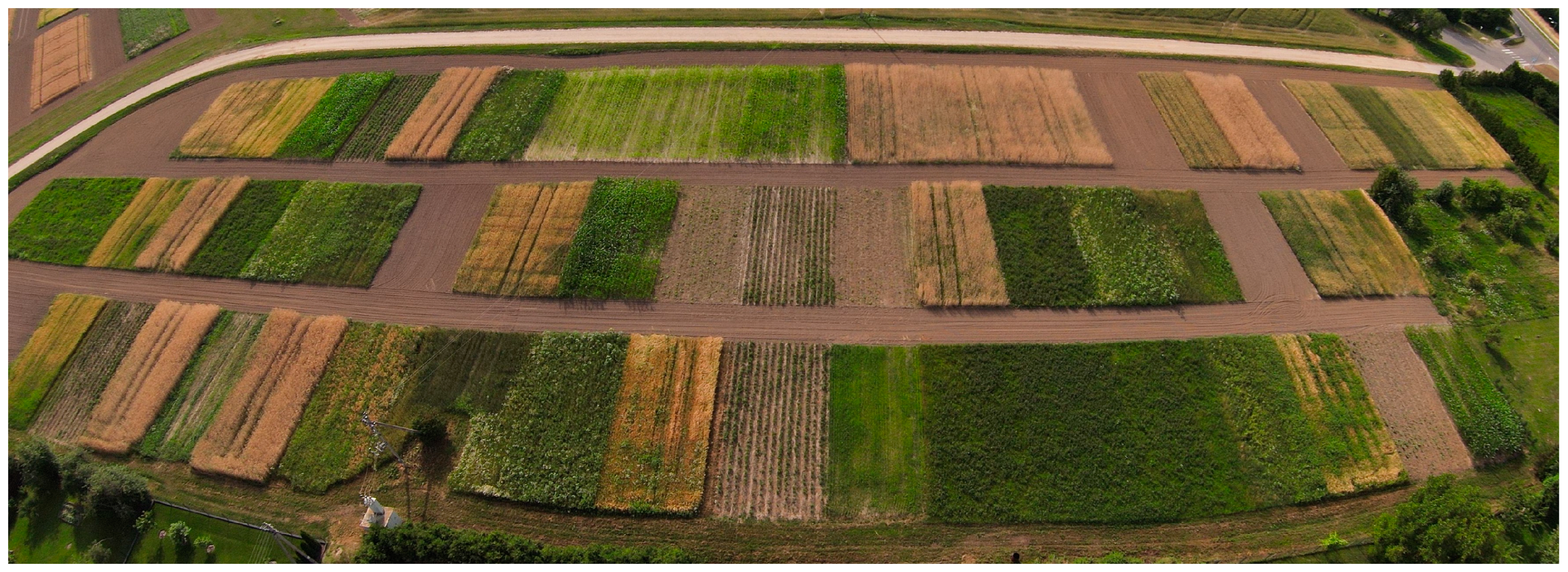


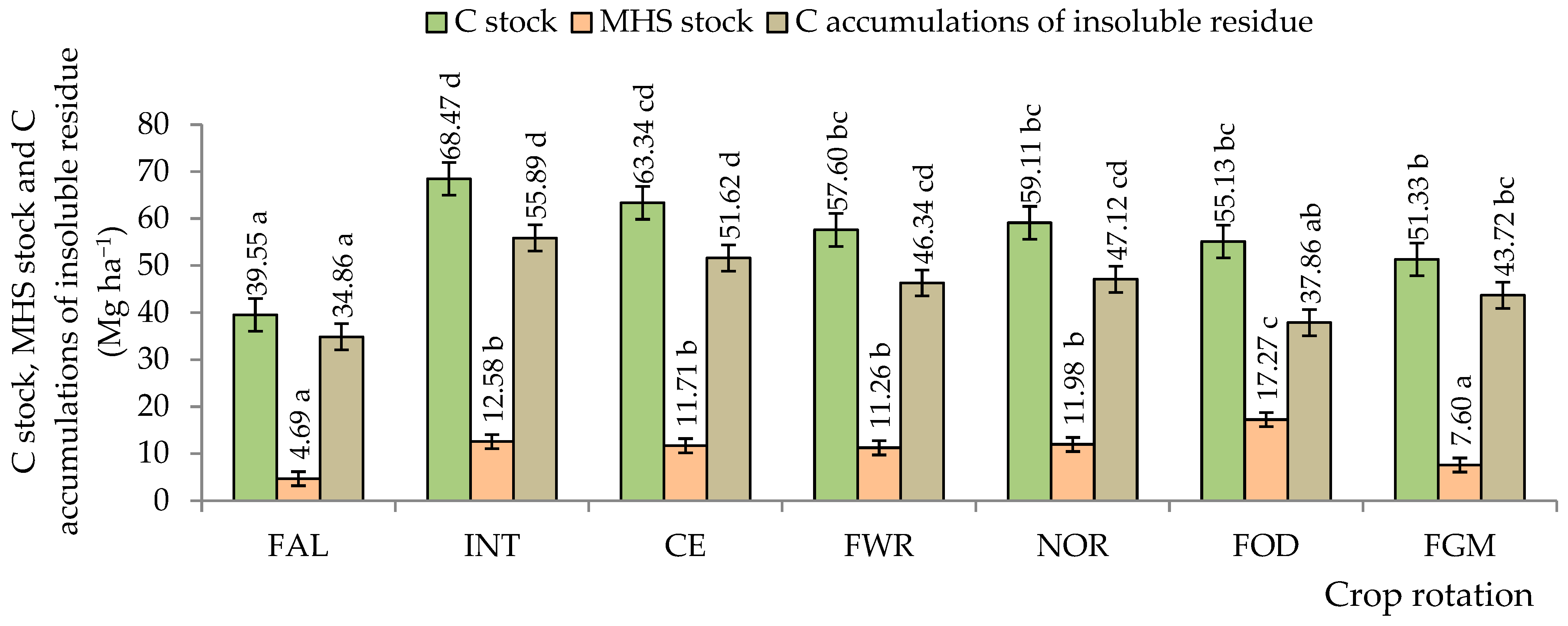


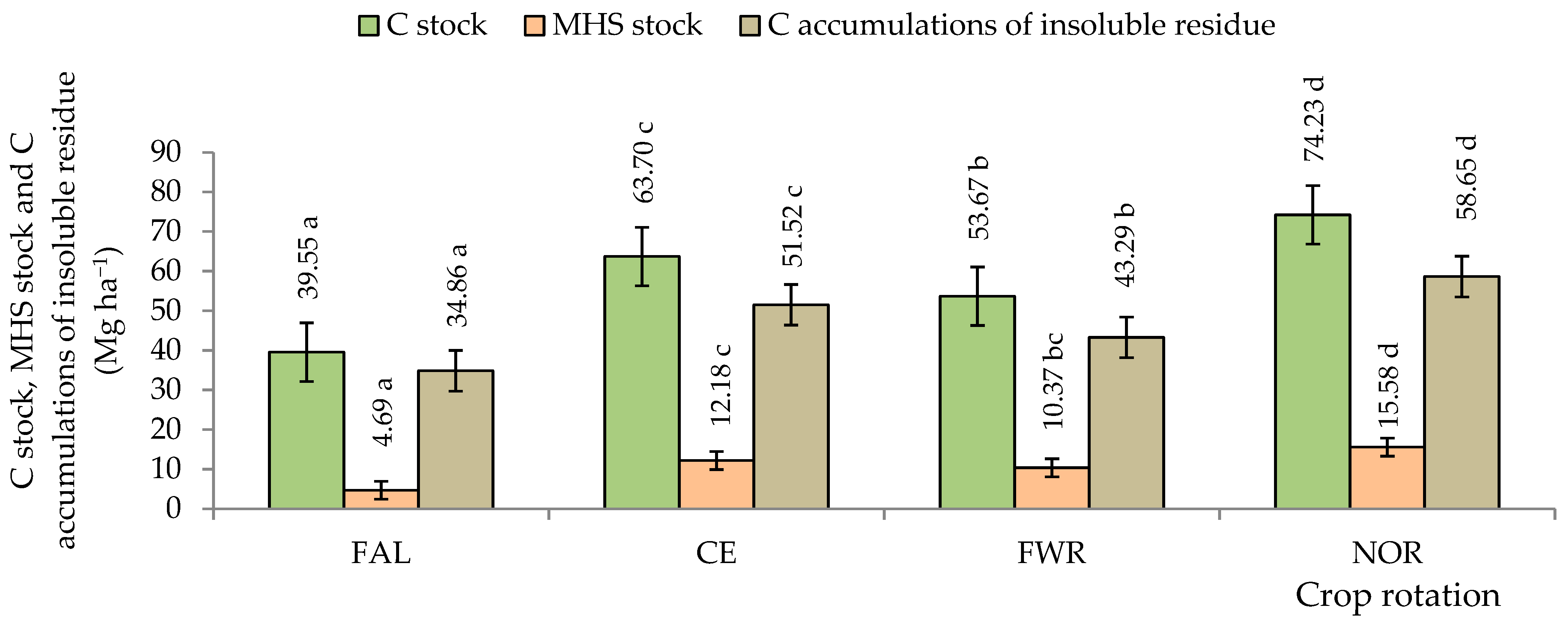
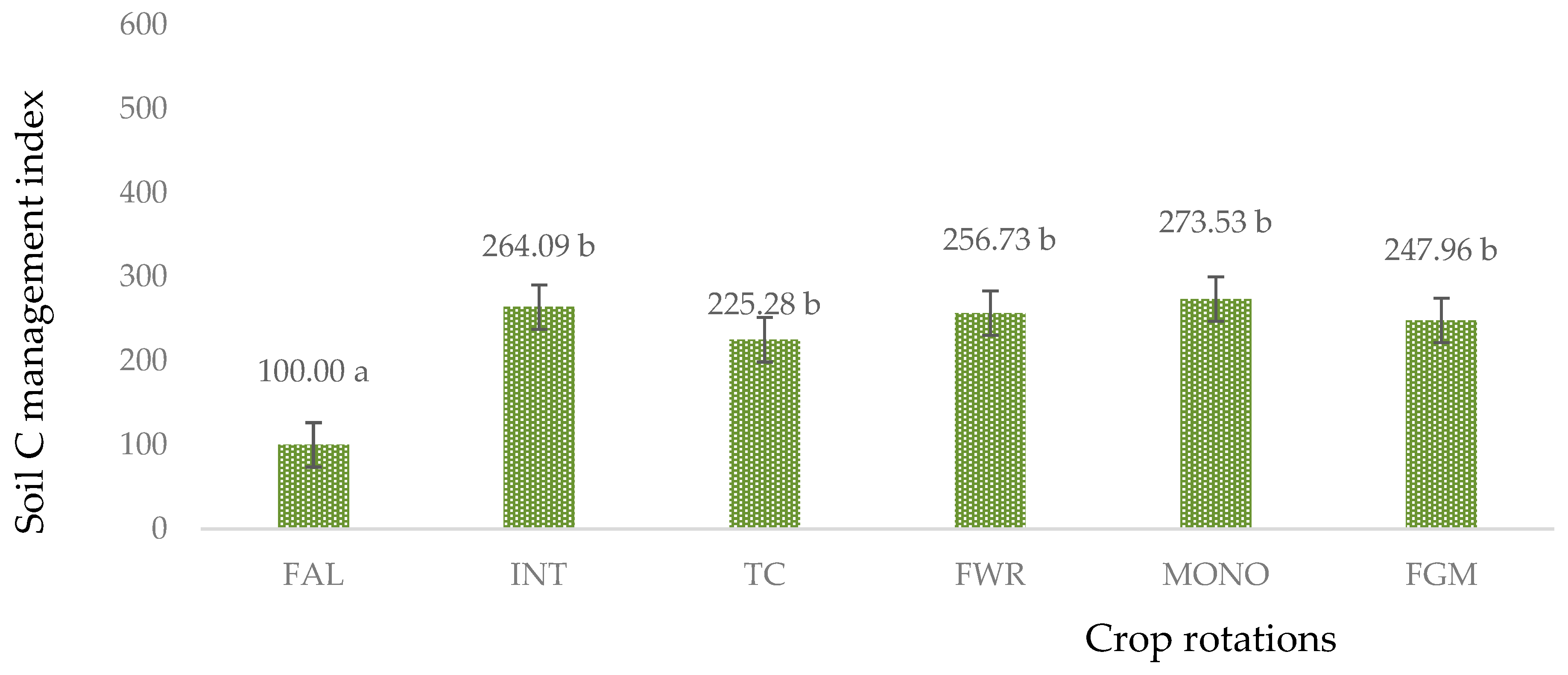
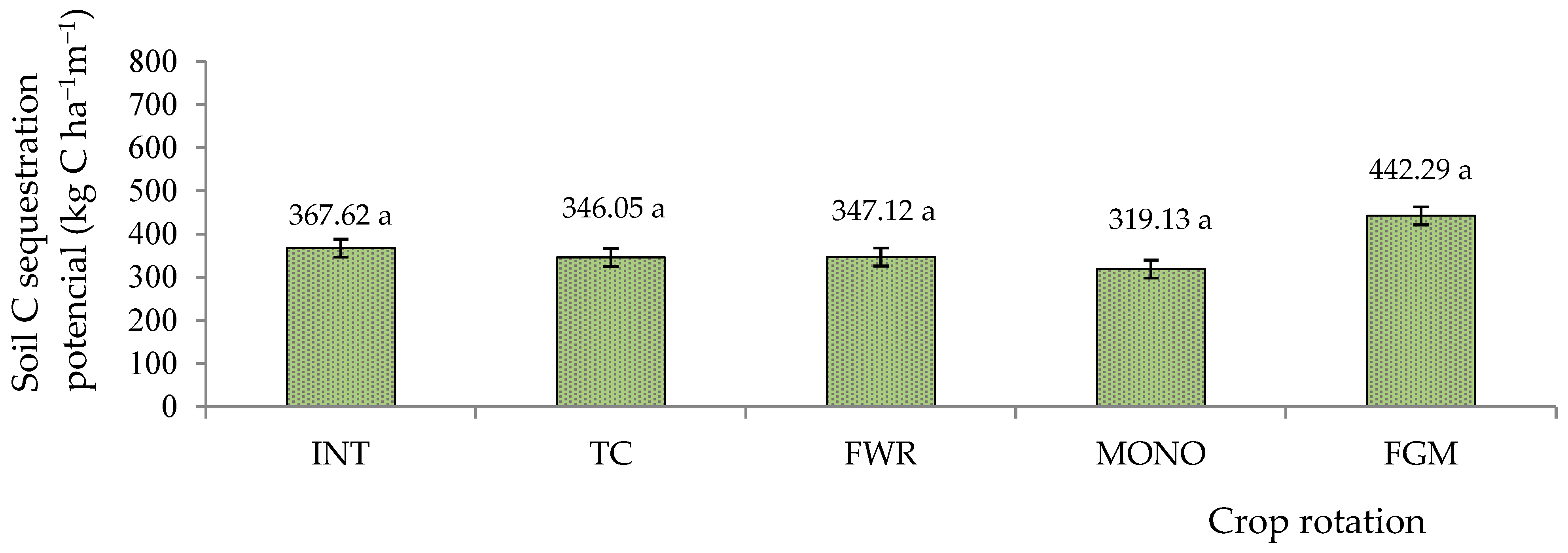
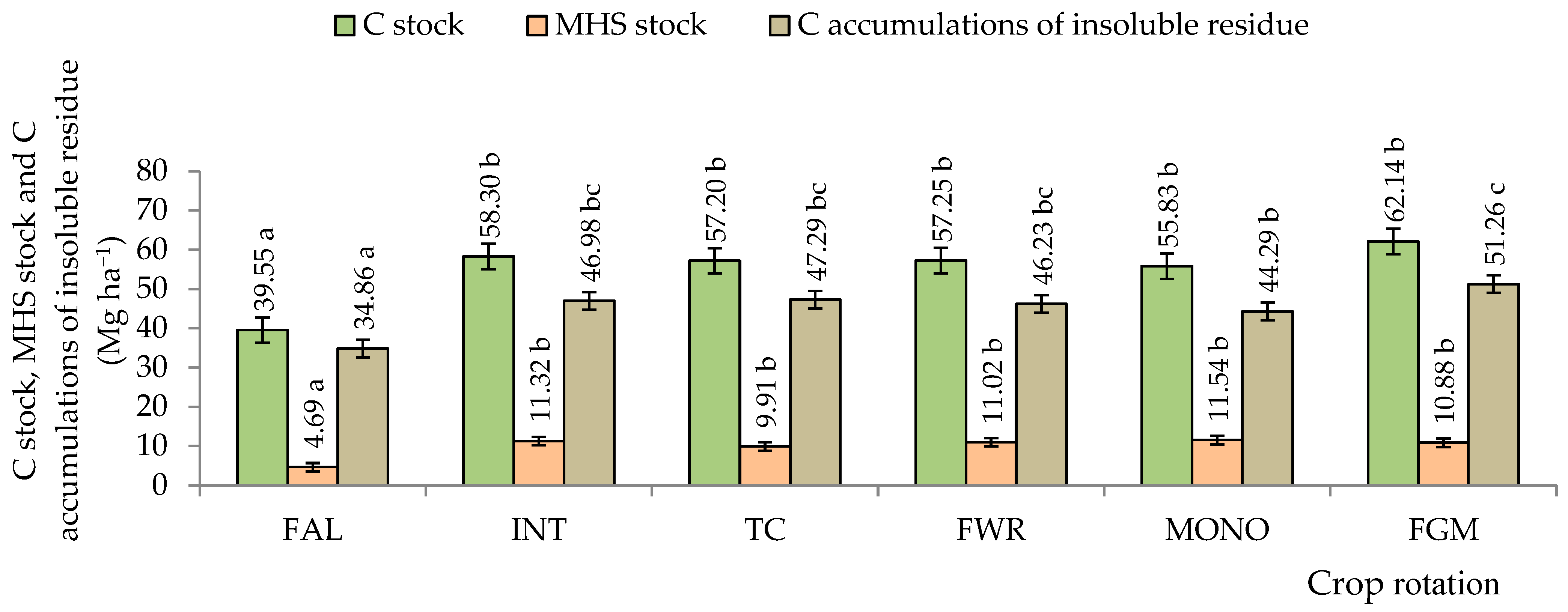



| Crop Rotation | Main Crop | Pre-Crop |
|---|---|---|
| Intensive (INT) | spring barley (Hordeum vulgare L.) “Orhelija” (180 kg ha−1) | Corn |
| Cereal (CE) | Vetch and oats mixture for green forage | |
| Field with row crops (FWR) | Sugar beet | |
| Norfolk (NOR) | Potatoes | |
| Fodder (FOD) | Fodder beet | |
| For green manure (FGM) | Potatoes | |
| Cereal (CE) | winter wheat (Triticum aestivum L.) “Skagen” (200 kg ha−1) | Oats |
| Field with row crops (FWR) | Black fallow | |
| Norfolk (NOR) | Clover–timothy mixture | |
| Intensive (INT) | winter rye (Secale cereal L.) “Matador” (180 kg ha−1) | Potatoes |
| Rye monoculture (MONO) | Rye monoculture | |
| Three-course (TC) | Black fallow | |
| Field with row crops (FWR) | Perennial grasses (second year) | |
| For green manure (FGM) | Winter rape | |
| Continuous black fallow (FAL) | ||
| Crop Rotations | Crops | Organic Matter (t ha−1) | |||
|---|---|---|---|---|---|
| Manure | Straw | Green Manure | Perennial Grasses | ||
| Intensive (INT) | Spring barley | 5.04 | 39.20 | ||
| Winter rye | 55.00 | 3.54 | 19.80 | 17.80 | |
| Rye monoculture (MONO) | Winter rye | 3.89 | |||
| Three-course (TR) | Winter rye | 4.10 | |||
| Cereal (CE) | Spring barley | 4.07 | |||
| Winter wheat | 55.00 | 7.76 | |||
| Field with row crops (FWR) | Spring barley | 4.76 | |||
| Winter rye | 55.00 | 3.57 | 2.80 | ||
| Winter wheat | 7.13 | ||||
| Fodder (FOD) | Spring barley | 4.52 | |||
| Norfolk (NOR) | Spring barley | 3.38 | |||
| Winter wheat | 55.00 | 6.38 | 32.00 | ||
| For green manure (FGM) | Winter rye | 3.68 | 19.50 | ||
| Spring barley | 4.35 | ||||
| Year/Month | January | February | March | April | May | June | July | August | September | October | November | December |
|---|---|---|---|---|---|---|---|---|---|---|---|---|
| Average air temperature (°C) | ||||||||||||
| 2020 | 2.5 | 2.2 | 3.6 | 6.9 | 10.5 | 19.0 | 17.4 | 18.7 | 14.9 | 10.3 | 5.2 | 0.6 |
| 2021 | −3.5 | −5.0 | 1.7 | 6.2 | 11.4 | 19.5 | 22.6 | 16.5 | 11.6 | 8.1 | 4.2 | −2.3 |
| 2022 | 0.02 | 1.4 | 1.7 | 6.2 | 11.0 | 17.7 | 17.9 | 20.9 | 11.1 | 10.2 | 2.9 | −2.5 |
| Long-term average | −3.7 | −4.7 | 0.3 | 6.9 | 13.2 | 16.1 | 18.7 | 17.3 | 12.6 | 6.8 | 2.8 | −2.8 |
| Precipitation rate (mm) | ||||||||||||
| 2020 | 52.8 | 54.9 | 29.3 | 4.0 | 94.4 | 99.3 | 60.4 | 92.8 | 13.3 | 52.5 | 30.0 | 17.1 |
| 2021 | 82.2 | 12.3 | 22.0 | 33.7 | 121.6 | 40.3 | 48.4 | 122.2 | 29.1 | 27.2 | 55.5 | 38.0 |
| 2022 | 69.0 | 73.7 | 3.60 | 38.4 | 84.0 | 77.6 | 100.5 | 38.7 | 26.0 | 17.7 | 30.7 | 44.1 |
| Long-term average | 38.1 | 35.1 | 37.2 | 41.3 | 61.7 | 76.9 | 96.6 | 88.9 | 60.0 | 51.0 | 51.0 | 41.9 |
Disclaimer/Publisher’s Note: The statements, opinions and data contained in all publications are solely those of the individual author(s) and contributor(s) and not of MDPI and/or the editor(s). MDPI and/or the editor(s) disclaim responsibility for any injury to people or property resulting from any ideas, methods, instructions or products referred to in the content. |
© 2024 by the authors. Licensee MDPI, Basel, Switzerland. This article is an open access article distributed under the terms and conditions of the Creative Commons Attribution (CC BY) license (https://creativecommons.org/licenses/by/4.0/).
Share and Cite
Skinulienė, L.; Marcinkevičienė, A.; Dorelis, M.; Bogužas, V. The Effect of Long-Term Crop Rotations for the Soil Carbon Sequestration Rate Potential and Cereal Yield. Agriculture 2024, 14, 483. https://doi.org/10.3390/agriculture14030483
Skinulienė L, Marcinkevičienė A, Dorelis M, Bogužas V. The Effect of Long-Term Crop Rotations for the Soil Carbon Sequestration Rate Potential and Cereal Yield. Agriculture. 2024; 14(3):483. https://doi.org/10.3390/agriculture14030483
Chicago/Turabian StyleSkinulienė, Lina, Aušra Marcinkevičienė, Mindaugas Dorelis, and Vaclovas Bogužas. 2024. "The Effect of Long-Term Crop Rotations for the Soil Carbon Sequestration Rate Potential and Cereal Yield" Agriculture 14, no. 3: 483. https://doi.org/10.3390/agriculture14030483






